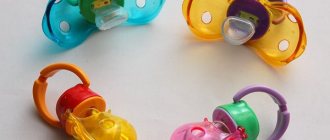Just a few decades ago, a newborn baby was cared for exclusively by the medical staff of the maternity hospital. Hygiene procedures, swaddling, skin treatment - all these concerns fell on the shoulders of the nurses. The woman in labor could only independently carry out the process of breastfeeding her baby.
Today, caring for a newborn in a maternity hospital is entirely the mother’s concern, except that nurses or a doctor can tell you how to swaddle or put a newly born baby to the breast. Many women attended preparatory courses during pregnancy, so they know how to perform all the necessary manipulations. But caring for a baby at home is one thing, but in the maternity hospital ward is completely different. Therefore, the mother must be ready for it even before her long-awaited miracle is born.
Caring for a newborn in the maternity hospital: basic elements
How to care for a newborn baby in the maternity hospital? Many women carefully prepare for this process, acquiring everything they need:
All necessary supplies for child care should be prepared in advance.
- baby cream;
- powder;
- baby body oil;
- soap;
- special wet wipes;
- diapers;
- diapers;
- change of clothes, etc.
Intimate hygiene
Intimate care for a newborn girl
in the first months of life is more difficult than for a boy, due to the special structure of the genital organs. It is important to properly wash the baby from front to back - to the anus. Otherwise, fecal particles may enter the vagina and cause inflammation.
Intimate care for a newborn boy
in the first months of life, it consists of daily washing the genitals and scrotum with boiled water (there is no need to forcefully open the foreskin). For underwear for a newborn baby, choose rompers made only from 100% natural cotton.
- Hygiene of a newborn boy
- Hygiene of a newborn girl
04.07.2016
Category: 0-3 months
- Share:
Changing diapers and the basics of proper swaddling
It is impossible to imagine caring for a child in the maternity hospital without swaddling. In this case, it does not matter at all whether there is a diaper under the diapers, or whether the new mother has not yet put one on her baby. Today, special preference is given to the so-called free swaddling, which allows the baby to move his legs, which has a positive effect on the development of motor skills.
But sometimes tying diapers tightly may be necessary, so a woman needs to learn this skill as well. This swaddling technique is especially important if the child’s nervous system is disturbed (a consequence of certain abnormalities during intrauterine development of the fetus). It is also performed so that the baby is not afraid of his own movements during sleep, which happens quite often. You should choose one method or another depending on the situation.
Note. If you do not know how to swaddle a baby correctly, do not hesitate to ask the medical staff of the maternity hospital or children's department. This will be much better than if you perform this procedure incorrectly, which could harm the baby.
Free swaddling is quite simple. The expectant mother should carefully wrap the diaper around each baby's leg. Thus, we get unique sliders that do not hinder the baby’s movements. Tight swaddling involves completely wrapping the newborn's legs, followed by tying knots on the surface of the diaper - in front or behind.
Step-by-step instructions for swaddling a baby
Changing diapers
Diapers for a newborn baby should be changed at least 8 times a day. Normally, newborn babies have bowel movements the same number of times. During the first bowel movements, the baby releases the first feces - meconium. It is black in color because it is a waste product of the baby’s body, which is formed during intrauterine development.
Note. As soon as the baby begins to eat normally, drinking exclusively mother's breast milk, the color of the stool will become normal. This can happen as early as 2-3 days after the baby is born.
After removing the soiled diaper, the baby's genitals should be cleaned of any remaining feces. This can be done using special baby wet wipes, or by washing. The use of soap is allowed only in extreme cases - when dirt cannot be washed off either with water or with the product with which the napkin is soaked.
After hygiene procedures, wipe the skin with a soft towel, apply powder and put on a clean diaper. Only when these manipulations are completed can the baby be swaddled.
You need to make sure that the diaper does not fit too tightly and does not put pressure on the baby.
The first days in the maternity hospital with a newborn
In the time of our mothers, everything was precisely planned. After the birth, the child was briefly shown to the mother and immediately taken to the children's department. The happy mother found herself in a postpartum ward for 6-10 people, where she spent time listening to neighbors' stories about all sorts of horrors, starting with six fingers on the hands of newborns and ending with the possible replacement of a baby. Three days passed in such a “pleasant” atmosphere, when finally the exhausted and tormented woman was brought her baby for the first feeding (before, the mother had no milk, why bring it!).
However, it is difficult to imagine that the children went without food for all these three days. Screaming babies were fed formula milk from bottles, and this practice did not stop until they were discharged from the hospital. Therefore, many mothers, receiving their children for feeding, could not wake them up - they were already full. And when they woke up and demanded food, mom was not around again, and they were given a bottle. It is not surprising that after such a start, few mothers managed to maintain long-term breastfeeding.
Fortunately, these days there are a large number of maternity hospitals that treat the first days of a baby’s life more humanely. Modern obstetric centers practice the “mother + child” system, when from the very first hours after birth, the mother and her baby are together. At the same time, neither the woman nor the child experience stress when separated from each other. Mom has the opportunity to feed the baby not according to a schedule, but on demand. She establishes lactation faster, and the baby receives such valuable drops of colostrum. Already in the maternity hospital, contact is established between mother and child, which is so important for their future life. Once at home, a woman is no longer afraid to approach the child and take him in her arms. She knows how to handle a newborn, because in the maternity hospital she had the opportunity to learn this from experienced nurses, and to try changing, bathing, and simply rocking the baby herself.
It is difficult to list all the advantages of being together with your baby from the first hours of life. However, sometimes one has to hear objections. First of all, they come from those who themselves gave birth “the old fashioned way” and from workers of such maternity hospitals, but also from future mothers who are not confident in their abilities. These doubts are evident in the conference on pregnancy and childbirth on the website 7ya.ru:
...maybe (and even probably) it’s a little hard to lie with a child immediately after giving birth, especially if it didn’t go entirely well - a caesarean section, or just stitches, or something else... (LightBug)
... many of my friends who gave birth both the first and second time say that it is better not to take the child with you, but to rest ... especially at night ... with the second it is easier, I think - you already know what and how ... and with the first on the first or second night - I’m thinking of giving it to the nursery... (Selena)
However, among women who have tried the “mother + child” system on themselves, it is difficult to find anyone who would be dissatisfied with it.
My firstborn and I lay together immediately after giving birth. That is, they brought me from the birthplace on a gurney and left me. I can’t say that it was very easy - stitches, fatigue, all that. But these are such trifles compared to worrying about your baby - how is he doing? Isn't it wet? Isn’t he crying?.. And so he is next to you, you rocked him and kissed him... They so need our warmth in the first days... I even put him to sleep with me, despite the cries of the pediatrician that I would strangle my own in my sleep son. It won't be very comfortable, that's true. But calm down! Both for the baby and for you. (Funtik)
It is definitely better to lie down with your child. Even if mom doesn’t feel well. Imagine: the baby was inseparable from you for 9 months, and suddenly childbirth (this is a test not only for the mother, but also for the child). And after all these misfortunes, he is taken to the nursery, where he lies in the incubator alone, his mother is not around, everything around him is unfamiliar and alien, he is given food not on demand (as it was in the stomach, when he was constantly fed), but on a schedule. Moreover, in the maternity hospital, so that children don’t scream so much, they are fed either formula or water with glucose - this is not very good for a newborn, and lactation improves better when the child eats on demand. And of course there is a psychological moment - the child feels abandoned, it’s like a betrayal on the part of the mother... You don’t give birth every day and you need to approach this moment responsibly. (Kitty)
For me this is a fundamental question. I chose only a maternity hospital where I could immediately lie down with my child. There is no need to worry about the fact that this is difficult - you can always ask that the baby be taken to the children's department when you want to rest, and after the next feeding you can leave him with you. In the maternity hospital where I gave birth, they swaddled the baby before each feeding, so I was spared this concern. During the day the baby was with me, and at night I gave her away - after the first night after giving birth I didn’t sleep at all (I gave birth the previous night, so it was too much). (Echomama)
They immediately put my daughter on my stomach and put her to my chest - after an hour, though. And when I heard the doctors discussing where to take us, I myself asked to go somewhere with the child. They were surprised - they say, you can handle it (there were gaps, oh-oh!..), but I convinced that I could handle it. And she did the right thing! Now I can’t even imagine how Liska and I wouldn’t be together... It seems to me that a lot in the relationship with the baby is laid down already in these very first days... (Marie)
Lately I have only one requirement for the maternity hospital (if I go there) - that the child lie with the mother. After all, this is important, first of all, for the child, he should not feel abandoned, he should know that at any moment, upon request, he will be warmed, fed, caressed, and he will finally just hear the beating of his mother’s heart, to which he is so accustomed in 9 months. I wonder if in a regular maternity hospital you demand your child, they won’t give it to you? And they will say: “It’s not allowed”? And by what right and law? At Christmas, during our classes we watched a Norwegian film about breastfeeding, where our modern practices (they also practiced this many years ago) were shown in black and white and talked about as if they were a horror film. (Nastic)
The most important argument in favor of staying together in the maternity hospital, of course, is feeding on demand. For a long time it was believed that a newborn should be fed strictly according to a schedule, not allowing deviations from it even for half an hour. Compliance with such a regime was costly for both parents and children. Only in recent years have pediatricians proven that feeding on demand does not disrupt digestion or negatively affect the stomach, but, on the contrary, contributes to a more harmonious development of the child, satisfying his individual nutritional needs.
Nowadays, even pediatricians from district clinics strongly recommend feeding babies outside of their schedule. And many women come to this idea on their own, obeying their own intuition.
I read in a magazine that in Africa, mothers constantly carry their babies in a bag on their chest and when they want, they then breastfeed. And because of this, they get sick less and behave much calmer. So I think that the future baby should be fed not according to a schedule, as all sorts of books advise, but when he asks. Maybe more experienced people will tell me that this is unrealistic, but I hope. (Natalie)
Unfortunately, I was in bed without Nastya and only when I was discharged I found out that she was fed additionally every time after feeding (without telling me about it), and sometimes, so as not to scream, even before feeding (the nanny told this in secret), and I I was surprised that she didn’t want to eat... Therefore, it is advisable to lie with the child or pay extra to the nannies in order to prevent such disgrace. (Irina)
The maternity hospital where I intend to give birth does not practice the “mother-child” system, and babies are brought there for feeding like everywhere else - every three hours, with a six-hour break at night. That's a total of 6 times a day. And the doctor dropped the phrase that the baby reaches for his mother’s breast up to 10-15 (!) times a day. But this is terrible! It’s not that he wants to eat 10-15 times a day, but that he only gets six... (LightBug)
A newly born baby is not able to withstand any feeding regimen - after all, the placenta fed him continuously! He wants to eat sometimes after an hour, sometimes after 4. And this is quite normal! I strongly recommend that everyone immediately lie in the ward with the child and not be afraid of anything. (Echomama)
Yes, the first time after childbirth is not the easiest in the life of a young mother. And yet, staying in a maternity hospital, even related to caring for a child, is much easier than what awaits you at home, where in addition to the child you will have to deal with housekeeping, washing diapers, and many other things. But you didn’t expect an easy life when you decided to have a child! So why not use the first days to the maximum benefit for yourself and your baby?
Changing a newborn
Caring for a baby requires regular changing of clothes, but do not overdo it - it will be enough to perform this procedure once a day. If there were no complications during childbirth, the baby eats normally, feels well and does not show any anxiety, he and the mother are discharged from the maternity hospital after 4 days. For this reason, a woman should stock up in advance on 3 sets of children’s clothing for every day and 1 for the long-awaited day of discharge.
When changing a newborn's head, be sure to support his head.
When changing your baby's clothes, you need to hold his head extremely carefully. A newborn baby is still very fragile, and the mother, especially if this is her first child, must be extremely attentive.
Before changing clothes, it is advisable to remove sweat and dust particles from the surface of the skin. After this, the natural folds on the baby’s body should be treated with special baby oil (if the epidermis is dry) or powder (if the baby sweats a lot or has oily skin from birth).
When applying cosmetic oil, you need to wait 20-30 minutes until it is absorbed, and only then dress your baby. This will help keep your clothes from getting dirty and prevent the formation of greasy stains.
How to trim nails?
Caring for a child means not missing anything, and not the last aspect of proper care is trimming nails, which are quite long in newborns. Don't be afraid - this is a very simple process that requires only attention, which will help avoid injury to the baby's delicate fingers.
To perform this procedure, purchase a special children's manicure set. It is sold in pharmacies and children's stores. With their help, it will be much easier for you to perform the manipulation. If this is not possible, use ordinary scissors with rounded ends. They will not damage the skin and will also prevent the appearance of hangnails. You should not trim your nails every day, as some mothers mistakenly believe - this should be done as they grow.
To trim your nails, you should use special children's scissors.
Caring for the umbilical wound
Newborn babies have one very vulnerable place - this is the umbilical wound, which is formed after cutting the umbilical cord. Instead, a special clothespin remains, which should remain until the remainder of the umbilical cord dries out and falls off.
The umbilical wound of a newborn requires special care
To prevent infection from getting into a fresh wound, it should be treated daily with a solution of hydrogen peroxide or a 1% solution of salicylic acid. If the navel does not heal well, it can be smeared with brilliant green, but such an order should only be given by a neonatologist or the doctor on duty at the maternity hospital.
It is important to remember that you should swaddle your baby or put on a diaper in such a way as not to affect the wound. It is better to tuck the edge under the fastener or inside the diaper.
Doctors and nurses are the first people you meet
It is the doctors and nurses in the maternity hospital who are the first to take on all the concerns of maintaining the health and caring for their little patients. This part of babies’ lives remains hidden from the eyes of parents, even in maternity hospitals, where babies and their mothers stay together. Many of us have a very vague idea of what happens to babies after their formal presentation to their mother. But most people are probably concerned about this issue. Let's try to lift the veil on this “secret life.”
Breast-feeding
If everything is relatively simple in how to care for the baby, then before the first feeding of the baby, many mothers begin to worry, worrying that nothing will work out for them. The first breastfeeding is carried out immediately after the baby is born, if, of course, this is possible (it’s just that some babies can fall asleep almost immediately after cutting the umbilical cord).
Breastfeeding is a non-verbal way for mother and baby to communicate
Breastfeeding ensures not only the saturation of the newborn, but also his close relationship with the mother. The child receives all the necessary nutrients that form his immunity.
In order to get used to the new process (for both mother and baby), it is necessary to communicate with the baby as often as possible through feeding. That's right - breastfeeding is one of the ways a baby communicates non-verbally with his mother. By putting your baby to your breast every 3-4 hours, you provide him with both nutrition and protection. He calms down because he feels completely safe.
Feeding is a great way to get rid of postpartum jaundice in newborns. Many mothers are familiar with this anomaly, and it seriously scares them. Mother's milk helps to activate the newborn's immune system, due to which the disease goes away much faster.
Caring for a baby is a very troublesome task, but these are very pleasant chores that a young mother will remember in the future with a happy smile on her face. Even though not everything will work out at first, mastery comes with experience, and pretty soon you will master all the necessary skills that will make you fully experience all the delights of motherhood.
What happens to the baby during the first 2 hours after birth?
Within the first 30 seconds after birth, the midwife cuts the umbilical cord. If the baby's father is present at the birth, he can, if desired, cut the umbilical cord himself. If it is necessary to collect blood from the umbilical cord for tests (blood type, bilirubin, etc.), then this is done right there. Then the neonatologist conducts an initial assessment of the baby’s condition and decides whether the baby needs resuscitation or not. If all is well, the baby is left in skin-to-skin contact with the mother for at least 2 hours.
What is happening at this time?
At the end of the 1st and 5th minutes, the doctor performs an Apgar score. 15-20 minutes after birth, as a rule, babies develop an appetite and begin to look for their mother’s breast. This is a signal that it is time to put the baby to the breast. Breastfeeding within the first 30 minutes after birth is very important for the baby's health. A newborn baby receives colostrum, which is essentially a cocktail of immunoglobulins, hormones, vitamins and other beneficial substances that are so necessary for the child. Thanks to early breastfeeding, the baby's intestines are seeded with microflora, which in the future protects him from allergies and dysbacteriosis. In addition, the intestines are cleared of meconium, which prevents severe jaundice. That's why it's so important to put your baby to the breast as soon as he starts looking for it.
During the first two hours, while the mother and baby are in the delivery room, the baby must have their body temperature measured at least 2 times: 30 minutes after birth and before being transferred to the postpartum ward. This is necessary to prevent hypothermia, which is very dangerous for newborns. Thermometry is carried out with an electronic thermometer, as it better records the child’s low temperature.
Approximately 1 hour after birth, but always after eye-to-eye contact between mother and child, the midwife treats the baby’s eyes with 0.5% erythromycin ointment or 1% tetracycline ointment to prevent conjunctivitis, which can cause blindness in the child. Therefore, the use of antibiotics at such an early age should not scare you, because this is done in the name of the baby’s health.










